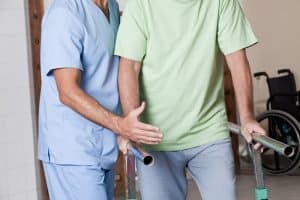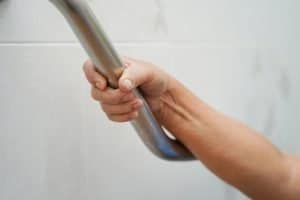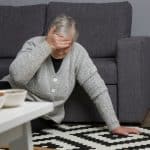
Physical therapy is helpful during fall recovery, but can be even more crucial to prevent the fall from happening in the first place.
As we age, we become more vulnerable to certain medical conditions or crisis events. While you might think about conditions like arthritis or dementia, there is actually a more serious threat to older adults: falling. Seniors are at an increased risk to fall at home, and to suffer more severe consequences if they fall, than their younger counterparts. Fortunately, the more you know about falls and how to prevent them, the less likely you are to become a fall statistic. And if you can have a safety net of automatic fall detection, you may be able to get help faster. Check out our Lifeline reviews for more information.
Facts About Falls and the Elderly Risk
The Centers for Disease Control reports that falling is a public health concern for seniors, and for good reason. One in every four seniors falls each year, though that number is likely low as some seniors who fall do not report it to loved ones or their physician. To make matters even more complex, if a senior falls, they are at risk to fall again.
Falling is scary and traumatic for many older adults, even if they do not end up in the emergency room or suffering long-term effects. Unfortunately, most falls lead to a crisis situation including hip fractures, concussions, or even premature death. About one in every five falls leads to a broken bone or head injury; nearly 3 million older adults visit the emergency room annually due to a fall.
Concussions, broken bones, and hip fractures often lead to unanticipated hospital stays which are expensive and never convenient. The Centers for Disease Control reports that in 2015, hospitalizations and medical costs due to older adult falls were approximately $50 billion. Medicare and Medicaid picked up about 75% of those costs.
Older adults can quickly become deconditioned in hospitals because they are staying in bed longer than they would if they are at home. Many older adults who end up in the hospital for more than three nights are transferred to a skilled nursing facility for rehabilitation prior to returning home again. This means that one fall can lead to weeks or months away from home for an older adult.
Finally, falls can lead to increased stress for family members. A fall incident can lead to medical bills and follow-up appointments as well as extra visits to ensure the senior is recovering well at home. Even just one fall can eliminate any peace of mind family members once had.
With all the bad news about the realities of falling, there is hope. Fall prevention techniques can decrease the risk of falling.
Can Physical Therapy Help with Fall Prevention? Research Shows Yes.
Falls happen for a variety of reasons, but nearly all fall incidents include decreased balance or stability. The Centers for Disease Control recommends focusing on overall mobility as one way to decrease fall risk. Feeling balanced and stable, as well as having increased strength and endurance, can lower your risk for falling at home or while out and about.
Many physicians recommend physical therapy as a component of a senior’s fall prevention plan. While many people believe that physical therapists only help during the recovery process of a fall or medical event, these medical professionals are also skilled at working with seniors to prevent the fall in the first place.
The American Physical Therapy Association points to documented research that early intervention is key to preventing falls in older adults. Physical therapists spend time working with seniors on balance and strength, but their exercises and expertise don’t stop there. Sessions can include time evaluating gait and working on making walking more efficient. Therapists can work with patients to eliminate shuffling or to use their mobility devices more safely at home and on the go.
Further, therapists can work on complex skills like holding a door open while stepping over a threshold or navigating transitions between flooring (like carpet to tile) that are often the causes of falling at home. Physical therapists can also work with seniors on any pain management issues that could be causing some mobility issues or simply to help seniors gain confidence while walking around their homes. Unfortunately, the fear of falling can create seniors to fall into a sedentary lifestyle which then actually increases their risk of falling.
If you are over the age of 65, it is wise to consult with your physician about a physical therapy order. Even visiting the therapist once per week and working on prescribed exercises at home throughout the rest of the week can significantly decrease the risk of falling.
What Home Modifications Can Be Made to Prevent Falls: Fall Prevention Checklist
Building strength and endurance, as well as increasing safe mobility, is a key component of your fall prevention plan. However, it’s not the only component. Evaluating and adapting your home environment can also significantly reduce the risk of falling. Here are a few rooms in your home that could use some modifications to keep you safe.
In the bathroom

Installing sturdy grab bars in the bathroom is an excellent fall prevention modification for your home.
Hands down, the bathroom is the most dangerous room in the home when it comes to falls. Thanks to slick floors and wet surfaces, even one slip can turn into a more serious tumble. When it comes to bathroom modifications, think slip-resistance and extra places to hold on.
- Eliminate all rugs in the bathroom that do not have slip-free backing.
- Use sturdy grab bars near the toilet as well as in the shower.
- Create a slip-free floor in the shower by adding slip-resistant stickers.
- Install a shower seat.
- Consider a walk-in shower instead of a more traditional bathtub model.
- Swap out the shower head for one that features a hand-held hose option.
- Eliminate extra clutter around the bathroom, including shelving systems that are not sturdy.
- Make sure you can navigate the bathroom safely with your mobility device.
- Consider a fall alert system that includes a waterproof pendant in case of a fall
In the bedroom
Next to the bathroom, the bedroom tends to be another dangerous room in the home when it comes to falling. This danger typically comes from needing to go to the bathroom in the middle of the night. Seniors are more likely to fall in dimly lit areas, as well as in the middle of the night. Be sure to change the lighting in these areas to prevent falls.
- Use nightlights near the bed.
- Consider motion-activated lights that turn on automatically when you are out of bed.
- Eliminate rugs that are not slip-resistant.
- Ensure any rug is secure at the corners.
- Clear a pathway from the bedside to the bathroom so that you will not need to navigate around pieces of furniture or floor clutter at nighttime.
- Consider installing a phone at the bedside.
In the hallway
Your hallway should be free from clutter and easy to navigate with your mobility device. Increase the safety by installing nightlights as well.
In the rest of the house
Finally, make the rest of the home safe with any of these modifications:
- Ensure all stairways are well lit at all times.
- Install grab bars for thresholds that require a step up, like coming in from the garage to the kitchen.
- Install a ramp, if needed, especially if there are multiple stairs to navigate coming into the home.
- Make the whole home easy to navigate by eliminating floor clutter, including clunky furniture or piles of boxes.
Preventing Falls
In addition to the toolkit of home prevention safety above, we want to provide quality fall prevention tips to aging adults based on research. By following a set of specific guidelines and utilizing a comprehensive fall prevention guide, the risk of falls can be greatly reduced. It all starts with a thorough evaluation of your living space using a fall prevention checklist like we provided above. Make sure to clear any potential obstacles from walkways, secure rugs and carpets, and install handrails in key areas. Consistent exercise, including balance and strength training, is crucial for improving stability. And don’t forget to schedule regular vision check-ups to address any potential visual impairments. By implementing these strategies, you can establish a solid foundation for a safer environment and take a proactive approach towards fall prevention.
Fall Assessment Guide
First, check the person’s condition immediately and asses for any signs of injury or distress. If an elderly person has hit their head, they should seek immediate medical attention. Taking blood thinners can make the situation even more urgent. Focus on areas of pain, swelling, or stiffness on certain parts of the body. If the person is unable to stand or walk, it indicates a serious injury and needs immediate medical attention. Additionally, examine the environment of the fall, look for hazards such as loose fabrics, slippery surfaces, or poorly lit areas and look for signs of disorientation or confusion, because these can mean underlying health issues. Encourage the person to report any problems or changes in health after a fall. Regular follow-up and a strategy to manage potential risk factors can help prevent future incidents and maintain the well-being of older individuals.
Effective fall prevention encompasses more than just household precautions. In addition to taking steps, such as eating a well-balanced diet to promote strong bones and staying hydrated to avoid dizziness, it’s important to also consider healthy lifestyle habits. This includes wearing supportive footwear with proper grip and regularly discussing medication usage with healthcare experts to manage any potential side effects that may increase the risk of falling. By having open conversations with your doctor about personal fall hazards and implementing personalized prevention measures, you can create an all-encompassing strategy that incorporates home modifications, lifestyle adjustments, and regular check-ins for optimal fall prevention.
What to Do If You Fall
Even with all of the best intentions and preventative practices, you might still fall at home. It is scary, to be sure, but you can still recover and create new prevention practices that will help you feel confident. See our guide too on how to get up after a fall.
- Review your current emergency contact list with your physician to ensure everyone is on the same page if you fall again.
- Review your current medication list, as some medication side effects include dizziness or low blood pressure upon standing.
- Research medical alert systems and devices; there are many choices and you are sure to find one that suits your style, budget, and lifestyle. Be sure to look at options that feature automatic fall detection.
- Make appointments for preventative physical therapy work.
- Consider bringing a physical therapist into your home to perform a site evaluation and offer suggestions for modifications that can keep you safer from falling.
- Talk to a therapist or healthcare professional, especially if you are feeling fearful after your fall. You can work on techniques that will build your confidence and decrease the trepidation you might feel while living alone.
- Set up safety check-ins with your family members. For example, you might feel more comfortable if you call or text your daughter before and after your shower so that if she doesn’t hear from you in 30-60 minutes she can follow up appropriately.
- Ask for help; your loved ones are there to provide emotional and physical support while you gain your confidence.
Falling can be traumatic and expensive. However, you can also take proactive steps to decrease your risk and increase your recovery potential. We also highly recommend for seniors who are at risk for falls to utilize a medical alert pendant with automatic fall detection. These systems can be used at home or on-the-go. Check out our medical alert reviews of companies, such as Lifeline and Medical Guardian, that provide these services nationwide.
National Fall Prevention Programs
The Administration for Community Living (ACL) has announced Falls Prevention Grants for 2023. These grant programs aim to support initiatives and topics focused on preventing falls among older adults. This national funding for fall prevention, is committed to addressing the challenges of falls among older individuals and is evident through the allocation of these grants to share with organizations working towards improving the safety and well-being of older adults. The implementation of these programs is great news for fall patients, healthcare professionals and the aging community as a whole.
Recovering from Falls
The road to recovery following a fall is a delicate and methodical journey that prioritizes a safe return to daily routines. Immediately after a fall, it is important to stay composed and carefully evaluate any potential injuries; including broken bones. In cases of serious injuries or simply hitting your head, immediate medical attention should be sought. For minor injuries, it is important to rest and give your body ample time to heal. Applying ice packs can help reduce any swelling or discomfort. As you begin to feel more capable, it’s advisable to incorporate gentle movements and exercises to rebuild strength and enhance flexibility. Seeking the guidance of a healthcare professional can aid in creating an appropriate rehabilitation plan. It is crucial to proceed gradually and pay close attention to your body’s signals, refraining from activities that give discomfort or pain. Falls can serve as a reminder to prioritize overall health, including maintaining a well balanced diet.


